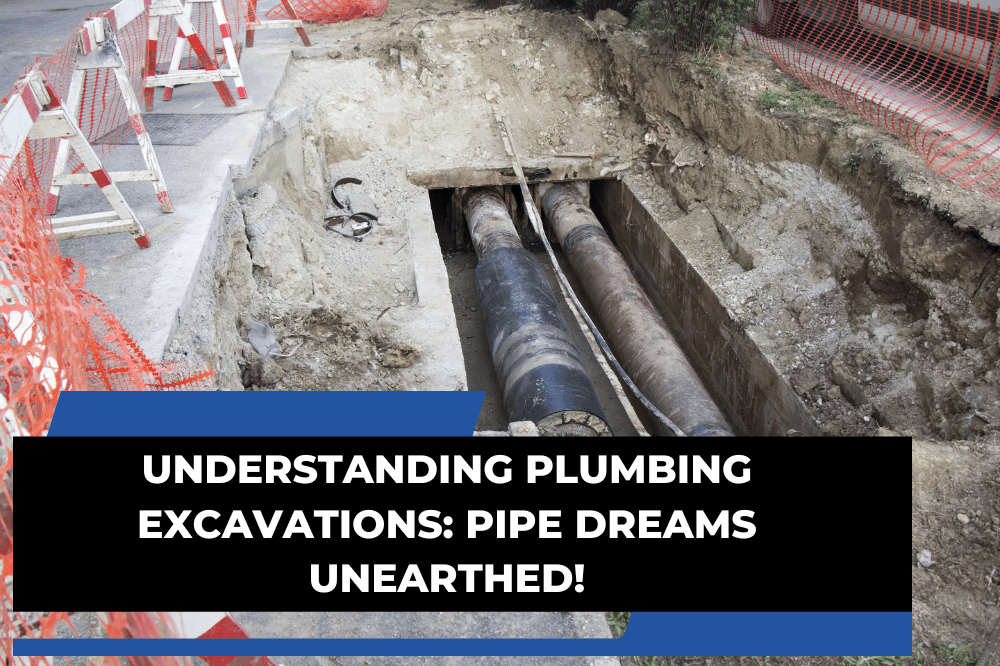Plumbing excavation is a term that you might not be familiar with unless you’re in the construction or plumbing industry.
However, it’s an essential concept for homeowners, property managers, and anyone interested in how buildings and properties function.
In this blog post, we’re going to demystify the concept of plumbing excavation, explain when it’s required, and give you a step-by-step overview of the process. So, let’s dive in!
Plumbing Excavation Demystified
Plumbing excavation is the process of digging and removing earth to install, replace, or repair underground plumbing systems.
It’s a complex operation that requires professional expertise, careful planning, and compliance with building codes and regulations.
The main aim of excavation in plumbing is to provide access to underground pipes. These might be part of various systems, such as sewer lines, water supply lines, or even gas lines.
The need for excavation can arise during new construction, or to address existing system problems like leaks, blockages, or structural damage.
When is Plumbing Excavation Necessary?
Plumbing excavation becomes necessary in the following situations:
- New Construction: When a new building is being constructed, excavation is required to install new plumbing systems.
- Major Repairs or Replacement: Excavation becomes necessary when the plumbing system is severely damaged. For instance, when pipes have collapsed, cracked, or broken due to age or poor-quality materials.
- Pipe Relocation: If there’s a need to relocate pipes due to changes in building layout or land use, excavation is required to remove old pipes and install new ones at the new location.
Trenchless Repair vs. Excavation
Trenchless repair methods have gained popularity due to their minimal disruption. However, they might not be suitable for all situations.
Despite the availability of trenchless methods, excavation might still be necessary when:
- The damage is severe, such as extremely damaged or collapsed pipes.
- The pipe configuration isn’t suitable for trenchless repair. For example, pipes with multiple bends, junctions, or those made of certain materials might not be compatible with trenchless methods.
- Local building codes and regulations require excavation for certain types of plumbing work.
The Location of Plumbing Excavation
The location of the excavation depends on the specific situation. It could be anywhere from the building’s foundation, the yard, the driveway, or even beneath the street if the issue lies with the connection to the municipal system.
How Do Plumbers Determine Where to Dig?
Plumbers use a mix of blueprints, pipe locators, and ground-penetrating radar to determine the exact location of the pipes.
They first locate the problem using diagnostic tools like drain cameras.
Once the issue is located, they use pipe locators or ground-penetrating radar to determine the exact location and depth of the pipe before starting the excavation.
The Plumbing Excavation Process
Here’s a step-by-step guide to how plumbing excavation is conducted:
- Preparation: The plumber will mark out the area to be excavated, ensuring it’s safe to dig.
- Excavation: Using a backhoe or excavator, the plumber will start the excavation process.
- Pipe Installation, Repair, or Replacement: Once the excavation is complete and the pipes are exposed, the plumber proceeds with the necessary work.
- Inspection: The work is inspected by a local building inspector to ensure it meets code requirements.
- Backfilling: After the inspection, the plumber backfills the trench, replacing the soil and compacting it to prevent future ground movement.
- Restoration: The final step is restoring the site to its original condition. This may involve replacing sod, pavement, or other surface materials that were removed during the excavation.
Conclusion
To wrap up, plumbing excavation is a vital part of plumbing work that involves digging into the earth to install, repair, or replace underground pipes.
Despite the advent of trenchless repair methods, excavation is still necessary in certain situations.
This process, while complex, is crucial to ensure the proper functioning of your plumbing systems.
Always remember that due to the expertise and specialized equipment required, it’s best to entrust such tasks to professional plumbers.
At True Service Plumbing we provide a range of plumbing services, including excavation. With our professional team and commitment to quality, you can be assured that your property is in safe hands.
Don’t hesitate to get in touch for any plumbing needs you may have!
Unearth the Best in Plumbing Excavation with True Service Plumbing
When it comes to plumbing excavation in Toronto and the GTA, True Service Plumbing stands as the trusted choice for both commercial and residential customers.
Our licensed professionals provide efficient solutions, whether it’s new constructions, major repairs, or pipe relocations.
Encountering underground pipe problems? Let our experts precisely diagnose and resolve the issue, minimizing disruption to your property.
Don’t let plumbing woes bury your peace of mind. Contact True Service Plumbing today. We’re here to ensure your plumbing systems are nothing but smooth sailing.


